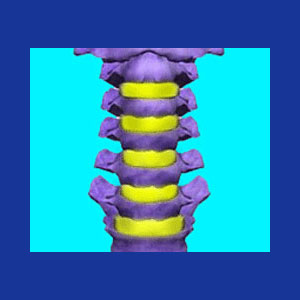
Straight neck syndrome is a diagnosis that implicates a loss of cervical lordosis as the cause of pain and possible neurological symptoms. Other common names for this particular form of neck pain include military neck, straight spine or hypolordosis. However, it must be made abundantly clear that most losses in the curvature of the neck are not overly symptomatic. In fact, many patients suffer no pain at all, even when demonstrating dramatic reductions in cervical lordotic curvature. Straight spine conditions can be diagnosed using any form of imaging study, such as x-ray, CT scan or MRI. However, many can be diagnosed by visual presentation and posture alone.
This discussion focuses on uncovering the mystery of straightened neck anatomies. We will explain why the neck is normally curved and what occurs when this typical arc straightens out to a minor or major degree.
Minor Straight Neck Syndrome
Minor versions of straight neck can be caused through many reasons, including congenital, developmental, degenerative or injurious processes in the spine, as well as non-spinal muscular explanations.
A mild loss in cervical lordosis is unlikely to cause pain, but may increase stresses within the spinal tissues and therefore magnify the rate of degeneration in the structures of the vertebral column. Minor hypolordosis is unlikely to present itself visually and may only be definitively diagnosable using comparative imaging films from a time prior to the lordotic changes taking place. Mild hypolordosis is not generally thought to be pathological and is rarely treated medically.
Some chiropractors will disagree with this innocent classification and may even justify ongoing treatment based on a preexisting congenital curvature condition that will never respond to continuing care. Likewise, some posture therapists and Alexander technique practitioners might justify ongoing care to correct minor lordotic alterations, as well. These techniques might be effective for a small parentage of patients who endure soft-tissue and posture-based hypolordosis, but will virtually never assist in spinally-enacted lordotic concerns.
Drastic Straight Neck
Substantial changes to the front-to-back cervical curvature stand a greater chance of being symptom-generators. Patients might experience neck pain, as well as the possibility for neurological symptoms, particularly when the lordotic change is compromising the central vertebral canal or neuroforaminal canal patency. Some patients suffer very little pain, but are extremely susceptible to spinal trauma from impact or shock to the vertebral column. Since the neck must support the heft of the head, any force applied will be compounded and therefore might create the ideal circumstances for significant neck injury to occur. While the disposition towards injury might not justify surgical treatment, patients might be highly restricted in their physical endeavors.
The worst cases of lordotic loss might actually continue to deteriorate and eventually become reversed curvature conditions, also called cervical kyphosis. While not inherently pathological, the majority of these patients do suffer pain and some even require terribly invasive forms of vertebral fusion surgery just to preserve the neurological capabilities of the spine.
Straight Neck Syndrome Synopsis
It is crucial to realize that there is a distinct difference between demonstrating a straight neck and being diagnosed with military neck syndrome. The former diagnostic term simply describes a change to the anatomy of the neck, with no symptoms implied. Meanwhile, adding syndrome to the diagnostic terminology expresses an inherent chronic and pathological component to the cervical anatomy alterations.
We have written extensively about the many possible changes in the lordosis and kyphosis of various spinal regions. In virtually every one of these possible changes in curvature, there are innocent versions and symptomatic versions. Unfortunately, doctors have a terribly difficult time telling the two different varieties apart. Here are the most troubling diagnostic scenarios:
Many patients with innocent and coincidental hypolordosis also have unrelated neck pain, or have pain from another condition that is actually causing the lordotic changes to occur. Meanwhile, the doctor incorrectly diagnoses the pain as being caused by the abnormal curvature. In virtually all of these cases, treatment will fail miserably.
Patient demonstrates a substantial hypolordotic condition, but the treatment selected is not indicated. This can occur when the condition is being enacted by soft tissue concerns, yet the treatment targets spinal consequences, rather than suspected spinal causation. Treatment failure can also result when there is a definitive spinal mechanism enacting the curvature change, yet therapy is targeting the muscles that are cramping as a consequence, rather than a perceived cause of the hypolordotic change.
Patients with symptomatic and severe lordosis reductions might be properly diagnosed and treated with spinal fusions. However, many patients will continue to worsen, since the effects of spondylodesis can be worse than the lordotic changes themselves. Patients might suffer terrible postoperative consequences from fusion surgery.
Other patients have no neck pain, but develop it through the power of the nocebo effect after being frightened by a doctor regarding their previously unknown curvature abnormality. This scenario demonstrates the power of the mind to create symptoms within the body, based on fear and anticipation of a condition becoming symptomatic in the future, rather than through any currently demonstrated structural mechanism.
Neck Pain > Cervical Spinal Lordosis > Straight Neck Syndrome





